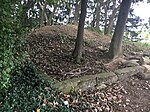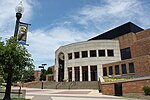Kent State University Ice Arena
College ice hockey venues in the United StatesKent State Golden Flashes men's ice hockey

The KSU Ice Arena is a two-rink ice complex located on the campus of Kent State University in Kent, Ohio, United States. The building contains two ice rinks, one with seating for 1,500 fans that is used for ice hockey and figure skating, with the other used for general skating. The two rinks are connected by a large lobby and snack bar. The facility also includes a meeting room and a skate-sharpening service. The building was built in 1970 and underwent a major renovation project in 2006–2007 which included seating and locker room upgrades in the main arena.
Excerpt from the Wikipedia article Kent State University Ice Arena (License: CC BY-SA 3.0, Authors, Images).Kent State University Ice Arena
Summit Road, Kent
Geographical coordinates (GPS) Address Phone number Website Nearby Places Show on map
Geographical coordinates (GPS)
| Latitude | Longitude |
|---|---|
| N 41.145555555556 ° | E -81.335833333333 ° |
Address
Kent State University (KSU)
Summit Road
44243 Kent
Ohio, United States
Open on Google Maps





